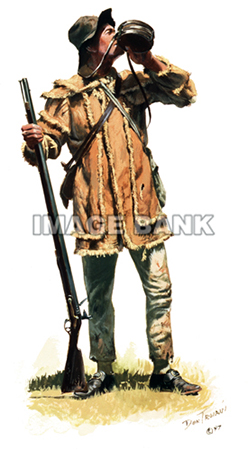 © Don Troiani Private, the Delaware Regiment, 1780 | A Brief Profile of the Continental Army© 1999 -- 2021 - John K. Robertson and Bob McDonald THE SUCCESSIVE "ESTABLISHMENTS" |  © Don Troiani Private, North Carolina Militia, 1780 |
|
The single, predominant factor affecting the successive organizational structures of the American army throughout the eight-year war was, of course, the Continental Congress. It was, at least from the standpoint of overall management and in spite of the states’ very consistent involvement with their own regiments, the army’s main “employer.” Based, however, on strongly held sociopolitical philosophies, inter-religious contentions, and deeply ingrained fears of any military force that were easily traceable at least to the English Civil War of the 1640s, the attitude of a significant portion of the political powers of the rebelling colonies toward the army upon which would fall the responsibilities for achieving that rebellion was innate distrust. The concept of a “career military man”, especially in predominantly Puritan-rooted New England, evoked images of royal placemen, pensioners, estate grantees, and the enormous web of aristocratic favoritism and corruption so characteristic of eighteenth-century Great Britain. Collectively, a social component consisting of several thousand armed men was, to many self-perceived zealous guardians of communal rights, a potentially enormous threat to the present and future liberties of a free society. In short, the development of a “professional” or “standing” army, even one created and committed to secure the “preservation of American liberties,” was almost never viewed by the Congress without an eye containing at least some degree of suspicion. The counter philosophy, and the concept greatly desired by the Congress as the basis for military resistance to Great Britain, was the model that has come down to us via a core myth of the Revolution as that of the “yeoman patriot.” Under this combination of monocular idealism, wishful thinking, and pure self-delusion, an army of freemen patriots would theoretically rise to defend their families, homes, communities and personal honor, figuratively plowing one day and wielding bayonets the next. Critically, it would be a new “army of Israel”, Puritan faith and a recognition of the gifts to be bestowed upon their posterity yielding innately invincible warriors over whom the forces of tyranny could never prevail. And, perhaps most demonstrative of the naiveté of this model’s crafters, the strongly prevailing view of the Congress regarding an ideal army was that military enlistment periods should not exceed one year because an army of freemen patriots neither would nor should diminish their status as freemen through longer military service. Thus, in June 1775, Commander-In-Chief General George Washington entered upon not only an eight-year military contest with London but also an eight-year political contest of judgment, will, tact and diplomacy with the Congress. As in all such political contests, the core issues were the acquisition, retention, and employment of the power to achieve designated ends. In addition to what might be regarded as a classic political contest, however, challenges and complications that could have been simply large often became enormous due to that political contest being not only a duality but a triangle, the third force being the individual colonies and, later, states. The critical factor in this equation was that these three elements were in no way equal in their a priori powers; the states inarguably and tightly held “the power of the purse.” Beyond the realities of broad and significant differences in the initial “designated ends” of the thirteen colonies and in their basic social structures, their inter-cooperation in this experiment called “the United Colonies” was purely and completely voluntary. While these independent, and not infrequently contentious, colonies unquestionably held the real power of wealth, the Congress had neither the fully committed allegiance of any colony’s legislature, nor did it have the authority to legally tax anyone to any extent whatsoever. Its ability to wage war was completely based on the arbitrary and voluntary collaboration of the colonies. And, as the sole instrument for the waging of that war, the Continental Army, if possible, possessed even less real power. Even less, that is, except for its commander. From his acceptance of command to the surrendering of his commission eight and one-half years later, it was Washington who was the consummate political “manager” of the Revolution as well as its peerless military commander. In a great many ways critical to the final outcome, Washington essentially served as “president” more than a decade before the establishment of the office through the drafting and adoption of the Constitution. Repeatedly, from 1775 to at least 1781, the sequential structures, or “establishments”, of the Continental Army represented a progressive, albeit at times begrudging, recognition that a current extent of latitude and degree of authority given to the military was clearly inadequate, and that greater power must be temporarily extended to it, at first to survive and, finally, to gain the independence of the United States. But, as will be seen in the profiling of the sequential “establishments” of the army described in succeeding sections, power was doled out to the army only on an absolutely as-needed basis. It would frequently require a major crisis to lever such power away from the states and the Congress, but when a given crisis was overcome, the army’s prerogatives were typically reduced. It was this near continual see-sawing across eight years that created a seemingly ever-changing Continental Army that even today presents difficulties of documentation and understanding. |
SYNOPSIS
INTRODUCTION
STRUCTURE & COMPONENTS
THE SUCCESSIVE "ESTABLISHMENTS" [This page]
THE ARMY OF 1775
THE ARMY OF 1776
THE ARMY OF 1777 THROUGH 1780
THE ARMY OF 1781 THROUGH 1782
THE ARMIES OF 1783 AND 1784
THE NEWBURGH CONSPIRACY
M&R NUMBERS

|

|

|